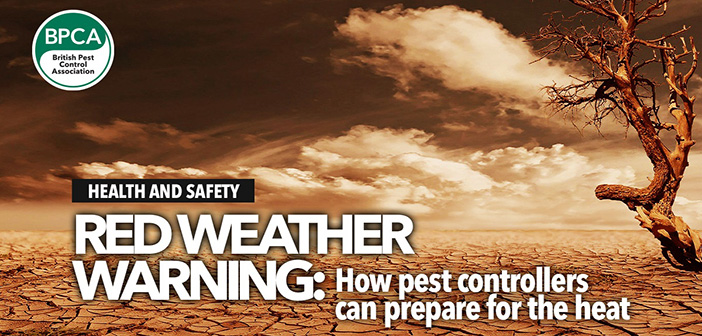For the first time in its history, the Met Office has issued a red weather warning for extreme heat in the UK.
A red weather warning is the most serious and means it is ‘very likely’ that there will be a risk to life.
The Met Office said: “Dangerous weather is expected and, if you haven’t already done so, you should take action now to keep yourself and others safe from the impact of the severe weather.”
What does this mean for pest professionals?
BPCA said it already was aware that some members that are self-employed are choosing to work in the mornings and late evenings, taking a break during the hottest parts of the day.
Legislation and Government guidance on acceptable working temperatures
Although there’s a lot of rumours about what the ‘maximum temperature’ is allowed to be in a workplace, the truth is that there is no set figure.
Temperatures in indoor workplaces are covered by the Workplace (Health, Safety and Welfare) Regulations 1992, which place a legal obligation on employers to provide a ‘reasonable’ temperature in the workplace. But what constitutes a ‘reasonable’ maximum temperature is mostly down to interpretation.
However, the Management of Health and Safety at Work Regulations 1999 require employers to make a suitable assessment of the risks to the health and safety of their employees.
This means employers do have a duty of care to employees, so appropriate controls should be in place and risk assessments undertaken to determine what those controls should be.
Employers should consult with employees or their representatives to establish sensible means to cope with high temperatures.
This could be providing air conditioning, refreshments, adjusting working hours so that field staff aren’t taking call outs during the hottest part of the day, allowing staff to relax formal uniform requirements in favour of cooler clothing where safe to do so, for example, shorts instead of trousers.
Employees are encouraged to talk to their employer if the temperature is uncomfortable and employers should address those concerns compassionately.
Practical implementation
Pest professionals work both indoors and outdoors, so it’s important to make sure you plan for the heat in both environments.
Location
When it’s this hot you should avoid working in spaces that could exhibit extreme temperature such as attics, ducts, etc. If you’re working outdoors try to stick to the shade where possible, and only work in direct sunlight where unavoidable and for short periods.
PPE
If you’re going to jobs that require you to wear heavy PPE like protective bee/wasp suits, consider booking those jobs for a cooler time of day, or asking your manager to do so. Take regular breaks, removing the PPE if safe to do so.
Sun cream
This is essential – you personally might not burn easily and think you don’t need it, but that doesn’t mean the UV rays are safe for you and you’re still at risk of skin cancer. Employers, you aren’t required to provide this for your staff, but it’s something you might consider doing.
Proper rests and hydration
Again, take regular breaks throughout the day, more than you usually would. The sun will tire you out and your decision-making could suffer, putting yourself and others at risk.
Travelling
Most pest technicians will be out in vans and others will be on foot in places like London. Either way, it’s important during the heatwave to take extra precautions to keep safe and well.


